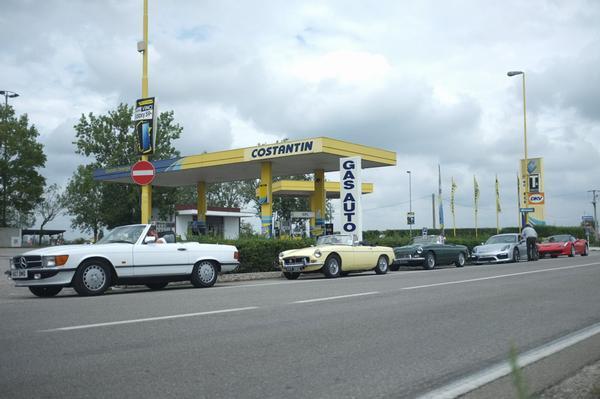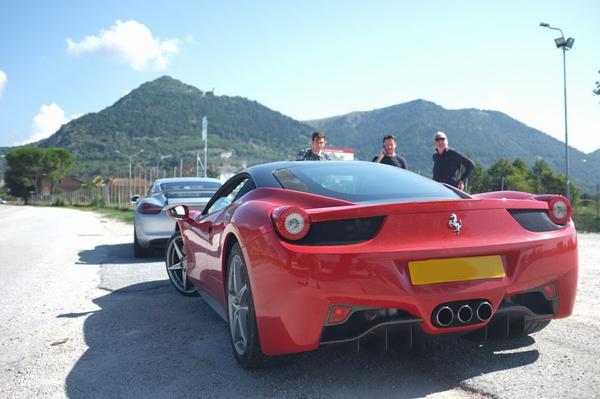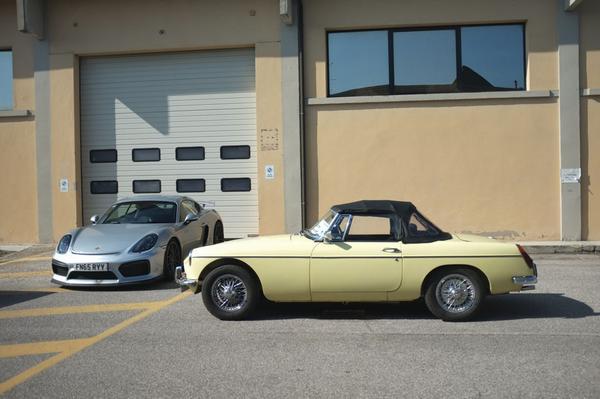PH takes an Anglo-Italian road trip
Why the pan-European drive still has worth, even if it is with your dad...

In these times of ultra-low-cost air travel, only goons like us think driving 1,000 miles from England to central Italy sounds exciting. Why suffer the torment of French motorway traffic and holidaymakers intent on climbing Swiss mountain passes at a snail’s pace, while paying extortionate continental fuel prices, when you can be in Tuscany in time for lunch with a £50 plane ticket?
Because cars are the best, that’s why.

Not your run-of-the-mill ecoboxes, mind, but proper enthusiast’s cars that make a journey of any length a real event. Take the Ferrari 458 Italia, Porsche Cayman GT4 and Mercedes-Benz 300 SL Roadster, plus an MG B and MG C, which teamed up on a road trip to Italy recently – one this PHer was very happily a part of. These are five cars that each will appeal to different people, as evident from the 35-year age gap between the youngest and oldest owners, but bring them all together on a transcontinental road trip and these machines offer much the same thing: completely enthralling driving experiences. That’s not something you can say about your average commercial flight.
The pace of these experiences would vary greatly on certain sections of our route, of course, with the 458 having 570hp at its disposal, and some of the older cars providing their rear wheels with less than 100hp. For this reason, the MGs were given a head start, leaving a day earlier so their drivers – which included my old man, no less – and passengers could complete a steady slog to Dusseldorf (to be explained) via a Calais ferry crossing. The Porsche, Ferrari and (at the rear) SL would take a different route comprised mostly of motorways to sprint to Dusseldorf station as quickly as traffic would allow.

Dusseldorf was to be the first stop because it is the starting point for a Motorail service to Verona. This train is 500 metres long and runs south through Germany via the gorgeous landscape that envelops the River Rhine into Italy, dragging double-deck carriages at its rear to carry cars. Using this was supposed to take the stress out the middle stint of our journey towards Italy, allowing us to relax and enjoy a night’s sleep as we’re hurtled southwards at speeds of up to 90mph – although it didn’t exactly work out that way. While the train ride itself was of no issue, the car carriages were a major cause for concern. The floor space they provided for the cars was barely two inches wider than the Ferrari 458’s tracks, meaning we had about the width of a thumb either side to navigate its 20-inch wheels into place on the train.
Then, of course, the inevitable happened.

Thankfully, the scuffs on the wheels looked worse than they eventually turned out to be. But even so, there was no getting away from the fact we’d stubbed the toes of a Ferrari 458. When we arrived at Verona it was therefore decided to crawl the car off the train with two people directing the driver which direction to steer – think of a lateral Chuckle Brothers and you get the idea. This took a long time, obviously, as the train is very long…
It did, at least, mean the Ferrari and its companions treaded onto Italian tarmac at Verona with – slightly scraped underside of GT4 front splitter aside – no further injuries. We therefore set about commencing our Italian road trip, ingeniously (ahem) nicknamed the Italian Job, in high spirits. Italy is home to some of the most picturesque, most technical and most enjoyable stretches of tarmac in Europe. We knew that from earlier trips there that involved hire car jaunts, so we were excited to get back behind the wheel, this time in some more interesting cars. But, for whatever reason – be it an economic downturn or extreme winter weather – the road surfaces we encountered were far worse than any of us recalled. The MGs rattled over seemingly endless bumps and broken surfaces, while the GT4, with its track-biased chassis setup, bounced and jiggled along; not even the 458’s Bumpy Road mode could make the surfaces feel acceptable. The SL, however, smugly glided over bumps, like a cloud passing above a densely packed mountain region.

At least the GT4 and 458 were presented with no shortage of tunnels to echo the barks and crackles of their naturally aspirated engines unto the eardrums of surrounding motorists. This being Italy, it seemed that every single passer-by appreciated the action, begging for more revs with waving hand gestures, flashing headlights and honks of horns. Driving supercars and sports cars in Italy remains as special an experience now as it ever has – and a stark contrast to that often provided in Britain.
Our trip included overnight (and sometimes two-night) stops in Artimino, Assisi and Castel San Pietro Terme (just outside Bologna), meaning there were plenty of opportunities for sightseeing and, more significantly for this trip, many miles of technical country roads to explore. Yours truly was called into action in the 458 on the twisting and refreshingly smooth section of tarmac called the SS222 (no, that doesn’t stand for special stage!) that was signposted to Siena. Not that I needed reminding, but the experience cemented my opinion that the 458 remains one of the greatest supercars to have made production, with its razor sharp throttle response, hunger for revs and single-seater-like dartiness. We know the GT4 is no less of a thrill, of course, and it proved to be ferociously capable on these billiard board-smooth surfaces. But, well, driving a Ferrari 458 in Italy is always going to be an unbeatable experience, isn’t it?

The cars weren’t without their problems. The Ferrari required two trips to main dealers for dash lights that, upon investigation by engineers, were simply switched off and followed by instructions to, as far as we could tell via broken English, stop worrying. One of the SL’s exhaust brackets needed tightening and the MG C was developing a worsening oil drinking habit. But every car completed the near 2,000-mile round trip successfully and without incident beyond the scuffing.
Yes, we spent many hundreds of pounds on petrol – so much that none of us dare add up the receipts – and yes, at times we were exhausted and longing for the next coffee stop. But mostly, we saw massive expanses of one of the world’s prettiest countries up close, soaked up the atmosphere of a car-obsessed culture first hand, and fell even further in love with driving each one of the cars that were piloted.

Not only does that make for a trip worth remembering, it also emphasises why so many of us continue to embark on road trip holidays in an age of bargain air travel. Long live the transcontinental driving holiday!








The Porsche would probably have been my initial choice if I were doing this trip, but reading about the track set-up chassis might have made me change my mind.... nah, the Porsche it is!
Gassing Station | General Gassing | Top of Page | What's New | My Stuff



